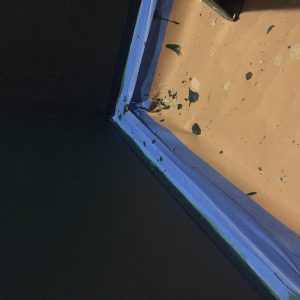What is the best way to install subway tile over this shower flange?
I installed hardie board and stopped it shy of the flange all around. Caulked gap between flange and backer board, then installed waterproofing fabric and Mapei Aquadefense to completely seal the backer board to flange.
However, the flange is recessed about a 1/4” from face of backer board.
Initially I was planning on applying the thin set and letting the bottom 1-1/4” or so of the tile just float over the flange gap. But then I started wondering how the heck I would be able to grout that. I would imagine the grout would just push into the cavity ?
Should I pack that recess with thin set when I trowel out the thin set for the first row? Would that cause an issue with possible movement between shower and hardened thin set? The shower pan was set in mortar.
What else would work?
Seems that I was so focused on making a waterproof assembly, that I took the tile install for granted!
Thanks in advance!




















Replies
You could have run the backer board over this flange.
At this point, your plan to let the tile hang is a good one.
The bottom row of tile can be caulked at the bottom, with silicone or other caulk meant for bathrooms.
For the gap, I would get some foam weather strip tape to fill the void. this should limit the extent of your grout intrusion, and maintain some independence to allow for any wall/pan movement.
This should work ok, as long as the tile is not too narrow. Not like you plant to get in the shower with your work boots on and kick the bottom of the wall.
Thank you for the reply. Pretty good idea on the weatherstripping tape.
Last night I was actually thinking of using something like that but on the top of the shower base to act like backer rod.
Then thinset the recess. After tile is up, cut some of the weatherstripping back and caulk.
Your idea is probably easier.
A. Backerboard should stop 1/2" above shower pan/ flange so it can't wick water, regardless of waterproofing.
B. Joint between wall tiles and shower pan/ flange should be caulked rather than grouted, as should be done for ALL corners and change of planes.
C. Place 1/2" wood spacer along length of flange and fill void with thinset. Allow to dry. Remove 1/2" wood spacer.
D. Tile wall, setting bottom edge of first course of tile in a bed of silicone caulk. Be sure to clean up excess caulk immediately.
E. Grout tile. Grout should be stiff so it self-supports in that <1/2" void joint. Also, give it a bit longer setting time before cleaning, so you can't push it through.
F. I would advise against using a foam backer behind the tile if the tile is less than 6". Too much opportunity for you to pop it with repeated wall scrubbings. BTDT.
Frankie
Thanks for the reply.
So with the 1/2” strip of wood, I would be leaving a 1/2” space to fill with caulk where the bottom of tile meets the top of the shower correct?
I should also note that the recess between shower flange and face of backer board is approx 1/8” - 1/4” due to fluctuations in the old framing.
DO NOT fill the 1/2" space with caulk or anything else. It is supposed to be a 1/2" SPACE/ VOID.
Silicone caulk is not applied to the backerboard. It is a bead applied to the flange, in which the first course of tiles is set. Alternatively, set the first course on 1/16 - 1/8" spacers and caulk joint after tiling has set. For a novice, setting tiles on spacers and caulking afterwards is easier - and better if it is a wood framed floor.
Frankie
I got ya. Thank you